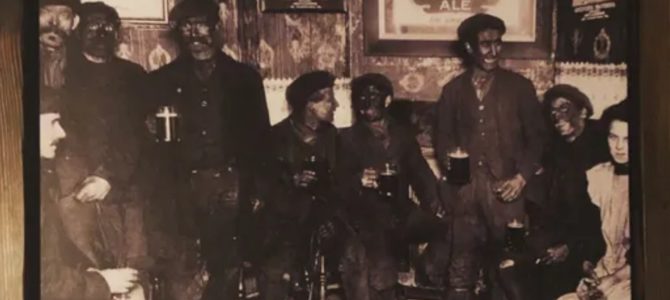
On Monday, AZCentral.com published an op-ed titled, “Phoenix restaurant says this is a photo of coal miners. But I see offensive blackface.” I won’t link to the story for reasons that will become obvious soon. The photo in question is a somewhat famous depiction of Welsh coal miners, circa 1910.
Here it is in a newspaper article from Wales, used to illustrate an article about Welsh history month. It should be patently obvious that there is absolutely nothing racist happening here. It’s just a bunch of miners standing around in a pub having a pint after a long day in the mines. Their faces are black with coal dust.
Instead, when confronted with this photo, Rashaad Thomas declares, “For me, the coal miners disappeared and a film honored for its artistic merit, despite being the most racist propaganda films ever, D.W. Griffith’s ‘Birth of a Nation’ (1915) surfaces, in which white actors appeared in blackface.” Thomas is well-aware that there’s nothing racist about the photo, yet says “the context of the photograph is not the issue.”
This idiocy is bad for two reasons. First, even if you want to grind some axe about the racial attitudes of post-Victorian England, Welsh miners were about one level above paramecium in the British social hierarchy. They were just blokes doing a job, and that job was ensuring people didn’t freeze to death and hospitals had electricity.
For their efforts, they were usually paid next to nothing and died early of black lung—that supposedly offensive stuff on their faces literally killed a lot of them. Their lives were generally so hard luck that when he ran for president in 1988, Joe Biden famously plagiarized the life story of a British politician from a Welsh coal mining family because he thought it would make him more sympathetic. To the extent that white privilege is a thing, Welsh coal miners are a really, really terrible example of it.
Second, last I checked, being black in contemporary America was not without its problems, such as kids being shot recklessly by cops over toy guns. If you get a public platform to address these problems, seizing on trivial nonsense such as this can actually make people discount the serious race-related problems.
This article isn’t a one-off. Newspapers publish this kind of nonsense nearly every day. In fact, the same day AZcentral published this article on Welsh coal miners, no less than The New York Times had an article on “‘Mary Poppins,’ and a Nanny’s Shameful Flirting With Blackface.” That’s right: according to the “paper of record,” Julie Andrews having soot on her face in a film where one of the major characters is a chimney sweep is racist.
Coincidentally, this is all based on yet another pretty specious reading of turn-of-the-20th-century English culture. I spent 20 minutes delving into the etymology of the word “hottentot” and walked away thinking that P.J. Travers was merely a product of her time, and by the standards of most of her contemporaries, not all that damnable.
In fact, this is all so pathetic that two different Twitter accounts jokingly predicted months in advance that both the same photo of Welsh coal miners and Julie Andrews as Mary Poppins would be used by social justice Rorschach analysts to cry racism.
How Did This Get Published?
Now, the reaction to this article might well be another day, another stupid opinion on the internet. But as a professional journalist who has worked at three magazines, two newspapers, and a wire service, there’s a big question here that far too few are asking: How did this get published?
This wasn’t some random article on the internet. AZcentral.com is the website of The Arizona Republic, which is affiliated with Gannett, the largest newspaper in the country. Professional news operations are supposed to have editors and gatekeepers who decide what does and does not get published. Some mysterious thing called “judgement” is supposed to be involved.
I can all but guarantee that this article did not end up on AZCentral without multiple people going over it. At no point did anyone ask themselves or their editorial colleagues, “Isn’t this article just cataloging an unjustified and petty grievance against a harmless restaurant owner who could be harassed as a result of publishing this?” And “How will this inform our readers and otherwise encourage them to have healthy and productive conversations about race?”
Newspapers ought to also consider how these extremist opinions that they publish reinforce the perception of bias. Right now, there’s a major advertising boycott being run against the popular right-wing website Breitbart. Why? Well, Breitbart ran a lot of ridiculous articles to get clicks, with headlines such as, “There’s No Hiring Bias Against Women In Tech, They Just Suck At Interviews,” and people on the left got offended. Even if you can’t excuse the blatant sexism of the article, the article is at least a bit self-aware, even tongue-in-cheek.
The AZCentral and New York Times articles, on the other hand, are written by people who are deadly serious, and unlike Breitbart, aren’t supposed to explicitly cater to one end of the ideological spectrum. And can you really say that their articles manufacturing complaints about blackface where none exist are somehow less divisive and damaging to discourse than Breitbart’s trolling? It just turns out that newspaper editors are by turns cowed by political correctness and more tolerant of left-wing extremism.
The effect (if not explicit hope) is that airing the extremism of only one side seems to be shifting the center of the national conversation leftward. Maybe that will win out in the end, but in the meantime, people have noticed that bias and the abdication of journalistic responsibility is polluting the discourse. Donald Trump is president, and public polling routinely shows that journalists usually rate somewhere between Lyme disease and paper cuts in favorability.
Surrendering Credibility
When you try to hold journalists to account about why such toxic articles get published, they usually deny any political motivations. To be fair, the economic incentives in the news business are skewed. Serious journalists usually shrug off the idiotic clickbait running under their own masthead and say that this is the nature of the business now. On some level, they’re not wrong.
Pre-internet, the limited amount of physical space in the paper (usually) provided a natural brake on publishing ridiculous or absurd opinions. Now that the pixels never run dry and the business model is getting as many clicks as possible, it has encouraged otherwise responsible news outlets to publish all kinds of things that get trafficked and shared on social media, often for no other reason than disbelief and outrage.
Newspapers aren’t even hiding that this is what they’re doing. The Washington Post’s website actually has an op-ed section called “Post Everything,” as if that’s some kind of journalistic ideal, and many and various opinion pieces published there suggest it isn’t. The op-ed section at The Guardian is called “Comment is Free,” and if you’ve spent anytime sifting through the nonsense there, believe me, you get what you pay for. Again, journalists will tell you that’s the point. The outrage clicks help pay for the important reporting the papers do elsewhere, and newspapers are in economic survival mode now that print ad revenues and subscriptions are drying up.
However, there are different kinds of journalism outlets for a reason. It’s one thing if the #SlatePitch is now the modus operandi for every niche opinion website. But newspapers, wire services, and other hard news outlets who have traditionally made money by servicing broad audiences ought to consider whether surrendering their credibility is worth it in the long run.
At this point, the molten “hot takes” designed to exploit cultural and political divisions clogging up the websites of ostensibly serious news outlets have thoroughly undermined any belief readers might have had that the front-page news stories were somehow handled much more judiciously. The journalism industry as we know it may have bleak prospects, but if it seems like late-stage journalism is yelling into the abyss, we should probably listen when the abyss yells “Fake news!” back.
If nothing else, someone should recognize this for the business opportunity that it is. People will gravitate to publications that have real news, less bias, and, to the extent it dabbles in opinion, judiciously selected and carefully edited commentary. Or at least that’s what they taught me in journalism school 25 years ago.
However, it seems like every time I fire up my web browser, or God forbid open an actual newspaper, I see a deluge of stories and columns that are by turns horrifying, fascinating, perversely entertaining, and above all, polarizing. You can call these articles a lot of things, but they sure aren’t journalism.









